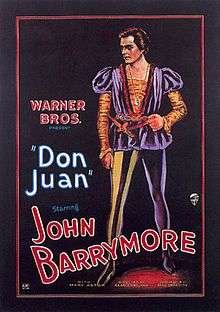Don Juan (1926 film)
| Don Juan | |
|---|---|
 theatrical release poster | |
| Directed by | Alan Crosland |
| Written by |
Walter Anthony (intertitles) Maude Fulton (intertitles) Victor Vance (art titles) |
| Screenplay by | Bess Meredyth |
| Based on |
Don Juan by Lord Byron |
| Starring | John Barrymore |
| Music by |
William Axt David Mendoza |
| Cinematography | Byron Haskin |
| Edited by | Harold McCord |
Production company | |
| Distributed by | Warner Bros. Pictures |
Release dates |
|
Running time | 112 minutes |
| Country | United States |
| Language | Silent |
| Budget | $789,963 |
| Box office | $1,258,000 |

Don Juan is a 1926 American romantic adventure/drama film directed by Alan Crosland. It is the first feature-length film to utilize the Vitaphone sound-on-disc sound system with a synchronized musical score and sound effects, though it has no spoken dialogue.[2] The film is inspired by Lord Byron's 1821 epic poem of the same name. The screenplay was written by Bess Meredyth with intertitles by Maude Fulton and Walter Anthony.[3]
Don Juan stars John Barrymore as the hand-kissing womanizer.[3] The film has the most kisses in film history, with Barrymore kissing (all together) Mary Astor and Estelle Taylor 127 times.[4]
Plot
In the prologue, Don José, warned of his wife's infidelity, seals his wife's lover alive in his hiding place and drives her from the castle; abandoned to his lust, he is stabbed by his last mistress, and with his dying words he implores his son, Don Juan, to take all from women but yield nothing. Ten years later, young Don Juan, a graduate of the University of Pisa, is famous as a lover and pursued by many women, including the powerful Lucrezia Borgia, who invites him to her ball. His contempt for her incites her hatred of Adriana, the daughter of the Duke Della Varnese, with whom he is enraptured; and Lucrezia plots to marry her to Count Giano Donati, one of the Borgia henchmen, and poison the duke. Don Juan intervenes and thwarts the scheme, winning the love of Adriana, but the Borgia declare war on the duke's kinsmen, offering them safety if Adriana marries Donati; Don Juan is summoned to the wedding, but he prefers death to marriage with Lucrezia. He escapes and kills Donati in a duel. The lovers are led to the death-tower, but while Adriana pretends suicide, he escapes; and following a series of battles, he defeats his pursuers and is united with Adriana.
Cast
|
|
Premiere Vitaphone short subjects
_(14733004466).jpg)
Don Juan premiered August 6, 1926, at the Warners' Theatre in New York City, New York.[5][6]
| Title | Year |
|---|---|
| Hon. Will H. Hays, President of the Motion Picture Producers and Distributors of America, Who Will Address You | 1926 |
| New York Philharmonic - Overture to "Tannhäuser" | 1926 |
| Mischa Elman - "Humoresque" and "Gavotte" | 1926 |
| Roy Smeck The Wizard of the String in "His Pastimes" | 1926 |
| Marion Talley - "Caro Nome" from "Rigoletto" | 1926 |
| Efrem Zimbalist and Harold Bauer - Theme and Variations from "The Kreutzer Sonata" | 1926 |
| Giovanni Martinelli - "Vesti La Giubba" | 1926 |
| Anna Case in "La Fiesta", Soprano Solo, Assisted by the Cansinos, Spanish Dancers, and the Metropolitan Opera Chorus | 1926 |
Production
George Groves, on assignment from The Vitaphone Corporation, was charged with recording the soundtrack to the film. He devised an innovative, multi-microphone technique and performed a live mix of the 107-strong orchestra. In doing so he became the first music mixer in film history.
Reception
The film was critically acclaimed upon release, as well as a box-office success. It was produced at a cost of $789,963, the largest budget of any Warner Bros. film up to that point. The soundtrack for the film was performed by the New York Philharmonic.
The film is recognized by American Film Institute in these lists:
- 2001: AFI's 100 Years...100 Thrills – Nominated[7]
- 2002: AFI's 100 Years...100 Passions – Nominated[8]
Preservation status
A print of Don Juan, including its Vitaphone soundtrack, still survives and is preserved at the UCLA Film and Television Archive.[4][9]
Home media
In 2011, the film, along with the original Vitaphone sound shorts, was released on manufactured-on-demand DVD by the Warner Archive Collection.[10]
See also
References
- 1 2 Don Juan at the American Film Institute Catalog
- ↑ Stephens, E. J.; Wanamaker, Marc (2010). Early Warner Bros. Studios. Arcadia Publishing. p. 25. ISBN 0-738-58091-0.
- 1 2 White Munden, Kenneth, ed. (1997). The American Film Institute Catalog of Motion Pictures Produced in the United States, Part 1. University of California Press. p. 195. ISBN 0-520-20969-9.
- 1 2 Don Juan at silentera.com database
- ↑ Hall, Mordaunt (August 7, 1926). "Vitaphone Stirs as Talking Movie". The New York Times. Retrieved 2016-05-01.
- ↑ Hirschhorn, Clive (1979). The Warner Bros. Story. New York: Crown Publishers, Inc. p. 32. ISBN 0-517-53834-2.
- ↑ "AFI's 100 Years...100 Thrills Nominees" (PDF). Retrieved 2016-08-20.
- ↑ "AFI's 100 Years...100 Passions Nominees" (PDF). Retrieved 2016-08-18.
- ↑ The Library of Congress American Silent Feature Film Survival Catalog:Don Juan
- ↑ Don Juan DVD release at silentera.com
External links
| Wikimedia Commons has media related to Don Juan (1926 film). |
- Don Juan at the American Film Institute Catalog
- Don Juan at the Internet Movie Database
- Don Juan at AllMovie
- lobby poster(DoctorMacro)